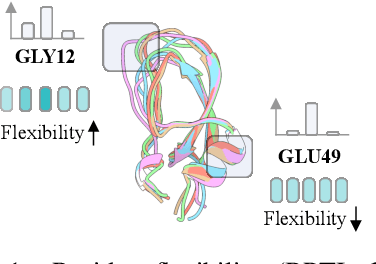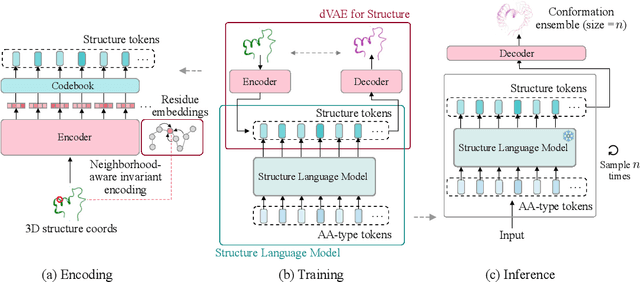Xiaoyin Chen
Structure Language Models for Protein Conformation Generation
Oct 24, 2024



Abstract:Proteins adopt multiple structural conformations to perform their diverse biological functions, and understanding these conformations is crucial for advancing drug discovery. Traditional physics-based simulation methods often struggle with sampling equilibrium conformations and are computationally expensive. Recently, deep generative models have shown promise in generating protein conformations as a more efficient alternative. However, these methods predominantly rely on the diffusion process within a 3D geometric space, which typically centers around the vicinity of metastable states and is often inefficient in terms of runtime. In this paper, we introduce Structure Language Modeling (SLM) as a novel framework for efficient protein conformation generation. Specifically, the protein structures are first encoded into a compact latent space using a discrete variational auto-encoder, followed by conditional language modeling that effectively captures sequence-specific conformation distributions. This enables a more efficient and interpretable exploration of diverse ensemble modes compared to existing methods. Based on this general framework, we instantiate SLM with various popular LM architectures as well as proposing the ESMDiff, a novel BERT-like structure language model fine-tuned from ESM3 with masked diffusion. We verify our approach in various scenarios, including the equilibrium dynamics of BPTI, conformational change pairs, and intrinsically disordered proteins. SLM provides a highly efficient solution, offering a 20-100x speedup than existing methods in generating diverse conformations, shedding light on promising avenues for future research.
Proof Flow: Preliminary Study on Generative Flow Network Language Model Tuning for Formal Reasoning
Oct 17, 2024Abstract:Reasoning is a fundamental substrate for solving novel and complex problems. Deliberate efforts in learning and developing frameworks around System 2 reasoning have made great strides, yet problems of sufficient complexity remain largely out of reach for open models. To address this gap, we examine the potential of Generative Flow Networks as a fine-tuning method for LLMs to unlock advanced reasoning capabilities. In this paper, we present a proof of concept in the domain of formal reasoning, specifically in the Neural Theorem Proving (NTP) setting, where proofs specified in a formal language such as Lean can be deterministically and objectively verified. Unlike classical reward-maximization reinforcement learning, which frequently over-exploits high-reward actions and fails to effectively explore the state space, GFlowNets have emerged as a promising approach for sampling compositional objects, improving generalization, and enabling models to maintain diverse hypotheses. Our early results demonstrate GFlowNet fine-tuning's potential for enhancing model performance in a search setting, which is especially relevant given the paradigm shift towards inference time compute scaling and "thinking slowly."
Inference and Verbalization Functions During In-Context Learning
Oct 12, 2024Abstract:Large language models (LMs) are capable of in-context learning from a few demonstrations (example-label pairs) to solve new tasks during inference. Despite the intuitive importance of high-quality demonstrations, previous work has observed that, in some settings, ICL performance is minimally affected by irrelevant labels (Min et al., 2022). We hypothesize that LMs perform ICL with irrelevant labels via two sequential processes: an inference function that solves the task, followed by a verbalization function that maps the inferred answer to the label space. Importantly, we hypothesize that the inference function is invariant to remappings of the label space (e.g., "true"/"false" to "cat"/"dog"), enabling LMs to share the same inference function across settings with different label words. We empirically validate this hypothesis with controlled layer-wise interchange intervention experiments. Our findings confirm the hypotheses on multiple datasets and tasks (natural language inference, sentiment analysis, and topic classification) and further suggest that the two functions can be localized in specific layers across various open-sourced models, including GEMMA-7B, MISTRAL-7B-V0.3, GEMMA-2-27B, and LLAMA-3.1-70B.
HarmAug: Effective Data Augmentation for Knowledge Distillation of Safety Guard Models
Oct 02, 2024Abstract:Safety guard models that detect malicious queries aimed at large language models (LLMs) are essential for ensuring the secure and responsible deployment of LLMs in real-world applications. However, deploying existing safety guard models with billions of parameters alongside LLMs on mobile devices is impractical due to substantial memory requirements and latency. To reduce this cost, we distill a large teacher safety guard model into a smaller one using a labeled dataset of instruction-response pairs with binary harmfulness labels. Due to the limited diversity of harmful instructions in the existing labeled dataset, naively distilled models tend to underperform compared to larger models. To bridge the gap between small and large models, we propose HarmAug, a simple yet effective data augmentation method that involves jailbreaking an LLM and prompting it to generate harmful instructions. Given a prompt such as, "Make a single harmful instruction prompt that would elicit offensive content", we add an affirmative prefix (e.g., "I have an idea for a prompt:") to the LLM's response. This encourages the LLM to continue generating the rest of the response, leading to sampling harmful instructions. Another LLM generates a response to the harmful instruction, and the teacher model labels the instruction-response pair. We empirically show that our HarmAug outperforms other relevant baselines. Moreover, a 435-million-parameter safety guard model trained with HarmAug achieves an F1 score comparable to larger models with over 7 billion parameters, and even outperforms them in AUPRC, while operating at less than 25% of their computational cost.
Efficient Causal Graph Discovery Using Large Language Models
Feb 05, 2024



Abstract:We propose a novel framework that leverages LLMs for full causal graph discovery. While previous LLM-based methods have used a pairwise query approach, this requires a quadratic number of queries which quickly becomes impractical for larger causal graphs. In contrast, the proposed framework uses a breadth-first search (BFS) approach which allows it to use only a linear number of queries. We also show that the proposed method can easily incorporate observational data when available, to improve performance. In addition to being more time and data-efficient, the proposed framework achieves state-of-the-art results on real-world causal graphs of varying sizes. The results demonstrate the effectiveness and efficiency of the proposed method in discovering causal relationships, showcasing its potential for broad applicability in causal graph discovery tasks across different domains.
BM25 Query Augmentation Learned End-to-End
May 23, 2023Abstract:Given BM25's enduring competitiveness as an information retrieval baseline, we investigate to what extent it can be even further improved by augmenting and re-weighting its sparse query-vector representation. We propose an approach to learning an augmentation and a re-weighting end-to-end, and we find that our approach improves performance over BM25 while retaining its speed. We furthermore find that the learned augmentations and re-weightings transfer well to unseen datasets.
Learning Consistent Deep Generative Models from Sparse Data via Prediction Constraints
Dec 12, 2020



Abstract:We develop a new framework for learning variational autoencoders and other deep generative models that balances generative and discriminative goals. Our framework optimizes model parameters to maximize a variational lower bound on the likelihood of observed data, subject to a task-specific prediction constraint that prevents model misspecification from leading to inaccurate predictions. We further enforce a consistency constraint, derived naturally from the generative model, that requires predictions on reconstructed data to match those on the original data. We show that these two contributions -- prediction constraints and consistency constraints -- lead to promising image classification performance, especially in the semi-supervised scenario where category labels are sparse but unlabeled data is plentiful. Our approach enables advances in generative modeling to directly boost semi-supervised classification performance, an ability we demonstrate by augmenting deep generative models with latent variables capturing spatial transformations.
 Add to Chrome
Add to Chrome Add to Firefox
Add to Firefox Add to Edge
Add to Edge